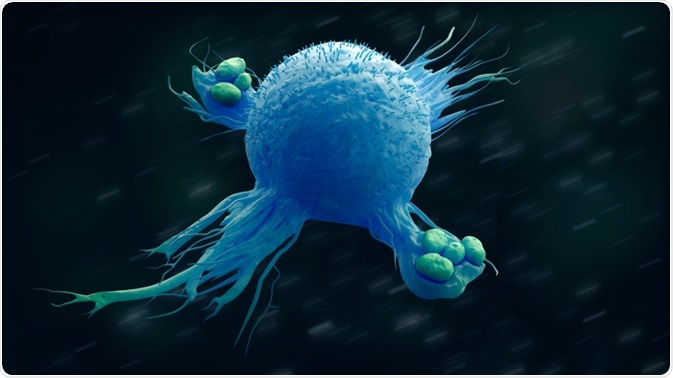Macrophages are types of white blood cells of the immune system that aid in the removal of foreign substances, from the body, by means of initiating an immune response. These are highly specialized cells that play a key role in the detection, phagocytosis, and elimination of harmful organisms. It does so using a recognition system, e.g., Toll-like receptors (TLRs) that bind to different pathogen components like sugars, RNA, DNA, etc.

Image Credit: urfin/Shutterstock.com
An additional function of the macrophages is to provide antigens to the T cells and initiate inflammation by releasing cytokines, thereby, activating other cells. These cells are present in almost all tissues of our body, although in different forms, such as Kupffer cells, osteoclasts, etc.
Monocytes are the first to respond whenever an infection occurs and, subsequently, they differentiate into tissue macrophages. The role of macrophages in the pathogenesis of inflammatory and degenerative diseases is quite important owing to their ability to eliminate pathogens and stimulate the immune cells.
Where and how do macrophages develop in our body?
Monocytes are the parent cells of macrophages and are present in the bone marrow. After leaving the bone marrow, the monocytes circulate in the blood, enter tissues, develop into macrophages. It must be noted that macrophages are extremely versatile and there is substantial heterogeneity among them, concerning their morphology, level of inflammatory cytokines they can produce, and the type of pathogens they can identify.
It is quite likely that this heterogeneous nature of macrophages has been inherited from their predecessors, i.e., monocytes. It has been well documented that a wide range of pathogens enters the human body through the respiratory system, gut mucosa, lesions on the skin, or the urogenital tract. Macrophages are usually the first line of defense as they are present in submucosal tissues.
Types of macrophages
As mentioned previously, there is substantial heterogeneity among macrophages. In terms of the important molecules that mediate macrophage action, scRNA-seq is critical to investigate macrophage heterogeneity and function. Some of the macrophages are as follows:
Alveolar macrophage: These macrophages are found in the Lung alveoli, hence the name. The principal function of these cells is the phagocytosis of dead cells or bacteria. Additionally, they also initiate and control immunity to a wide array of respiratory pathogens.
Kupffer cells: Kupffer cells are found in the liver, within the lumen of the liver sinusoids. These bring about immune responses and tissue remodeling.
Microglia: These cells belong to the central nervous system and are responsible for the elimination of old or dead neurons. Additionally, they also control the immunity in the brain.
Splenic macrophages: These cells are found in the Spleen and help in the elimination of dysfunctional or old red blood cells, from the body.
Macrophage phenotypes
As discussed earlier, macrophages have different phenotypes and functions. Broadly macrophages can be classified into two distinct subsets - classically activated (M1) macrophages and alternatively activated (M2) macrophages. M1 macrophages are polarized by Th1 cytokines and produce pro-inflammatory cytokines such as interleukin-1β (IL-1β), IL-6, IL-12, IL-23, and TNF-α.
On the contrary, M2 macrophages are polarized by Th2 cytokines and produce anti-inflammatory cytokines such as IL-10 and TGF-β. Recent research has shown that it is not sufficient to characterize all stages of macrophage activation in this manner as they are extremely elastic and can change polarization depending on the stimuli.
The cellular metabolism is also quite different among the M1 and M2 macrophages, i.e., M1 macrophages rely on glycolysis while the M2 category depends on oxidative phosphorylation.
Role of macrophages
Macrophages play a very essential role in fighting diseases as part of the immune system. Moreover, they can assume a negative role in chronic inflammation, autoimmune diseases, etc. Macrophages circulate within almost every tissue, patrol for pathogens or harmful organisms, and eliminate dead cells. These cells are key in the wound healing process and immediately after the injury has occurred, pro-inflammatory M1 macrophages reach the wound site and start the process of cleaning the wound of dead cells and harmful bacteria.
During the process of tissue repair, M1 macrophages transition to their M2 counterparts, which are anti-inflammatory. Both these processes are extremely important in the course of tissue repair. Additionally, macrophages also play a key role in wound vascularization, i.e., fusion and stabilization of the new blood vessels. It must be noted that this process of transition of pro-inflammatory macrophages to anti-inflammatory macrophages is hampered in chronic conditions, such as diabetic wounds.
Macrophages can also clear away tumor cells. Tumor-associated macrophages (TAMs) are capable of being polarized into M1 or M2 phenotypes, depending on the tumor microenvironment and these different polarizations have very different implications for tumor development and chances of overall survival.
Researchers have shown that high numbers of M2 macrophages in patients with gastric cancer were associated with a lower rate of survival, while a higher number of M1 macrophages led to more favorable outcomes in terms of overall survival. Therefore, an accurate understanding of TAMs could be extremely beneficial for cancer immunotherapy.
Sources:
- Britannica, T. Editors of Encyclopaedia. (2020) Macrophage. Encyclopedia Britannica. [Online] Available at: https://www.britannica.com/science/macrophage
- Saldana, I, J. (2021) Macrophages. British Society for Immunology. [Online] Available at: www.immunology.org/.../macrophages
- Zhang, C. et al. (2021) Function of Macrophages in Disease: Current Understanding on Molecular Mechanisms. Frontiers in Immunology. 12, pp. 635. DOI=10.3389/fimmu.2021.620510
- Singh, K. and Sen, K.C. (2020). Epigenetics of diabetic wound healing. Wound Healing, Tissue Repair, and Regeneration in Diabetes, Academic Press, pp. 167-180, https://doi.org/10.1016/B978-0-12-816413-6.00009-5
- Macrophage Cell Overview. (2020) Thermo Fisher Scientific. [Online] Available at: www.thermofisher.com/.../macrophage-cell-overview.html
Further Reading
Last Updated: Sep 27, 2021